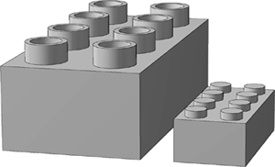The LEGO system is always evolving with the addition of new elements, colors, and updated set designs that reflect the times. Perhaps one of the more significant additions to the system came in 1978 when the miniature figure, better known as the minifig, was added. The most basic version of a minifig is shown in Figure 3-1.
Although it is really a collection of three pieces (legs, upper body, and head) the minifig typically arrives as two pieces (legs and upper body with the head already attached). Once you’ve built a set containing a minifig, you’ll probably leave it fully assembled, often with some style of hair or hat and sometimes with a tool or other accessory to hold in its hands.
Over the years, I’ve seen many different types of minifig, with a wide variety of different styles and costumes—from astronauts and cowboys to helicopter pilots, racecar drivers, and many more.
No matter how big your LEGO collection is, you probably have a few minifigs lurking about. It seems only fair then that you look at building a world to their scale.
Simply put, scale is how you describe the relationship between the size of one object and the size of another.
But what is minifig scale? For simplicity’s sake, assume that from the point of view of the minifig, a minifig is, on average, about 6 feet tall—not the 1 1/2 inches that you measure it to be. In Figure 3-2, you can see that your basic minifig just barely gets to that mark on a ruler.
Figure 3-2. How does a minifig measure up? In our world he’s only an inch and a half. In his world he’s six feet tall.
Having made this assumption, you know that 1 1/2 inches in the world of minifigs represents 6 feet in our world. Let’s take that information and figure out the scale.
To convert to minifig scale, do the following:
First, convert 6 feet into inches. Because there are 12 inches in a foot, the calculation is pretty simple.
12 inches x 6 feet = 72 inches
Then, divide your model/minifig height into your real height.
72 inches ÷ 1.5 inches = 48 inches
In other words, this is the formula:
Height of same object in your world ÷ Actual model height = Scale value
Finally, create your scale. Your minifig is
1:48 scale (pronounced "one-forty-eighth" or "one to forty-eight")
Scales are shown as two numbers separated by a colon. The number on the left represents one real object. The number on the right represents the number of scale objects it would take to equal the same size. (You may see scale written as a fraction, like 1/48, but the meaning is the same.)
This scale tells you that if you could stack 48 minifigs on top of each other, without having them tumble down, they would equal just about 6 real feet in height.
Figure 3-3 shows another even simpler example. A standard 2x4 brick is shown to the right of a 2x4 Duplo brick. These larger bricks are part of LEGO’s line of products aimed at younger children. By comparing these two pieces, you see an easy-to-understand example of a 1:2 scale. In other words, for every one Duplo brick, you need two regular bricks to equal the same dimension, because Duplo bricks are twice as high, twice as wide and twice as long.
Once you have the scale figure, you can use it to work backward, taking a real life object and deciding how big it should be in your minifig world. Let’s use an example of a house, because you know every minifig will want one or two. Let’s say that the house you want to use as inspiration is 24 feet tall in real life. This time you divide the actual height (24 feet) by your scale value (48).
24 feet = 288 inches (converted to inches so that your result is in those units) 288 ÷ 48 = 6 inches Real object height ÷ Scale value = Size of scale model
It’s easy to see that your minifig scale house should be 6 inches tall in order to accurately represent the actual building you’re using as your guide.



